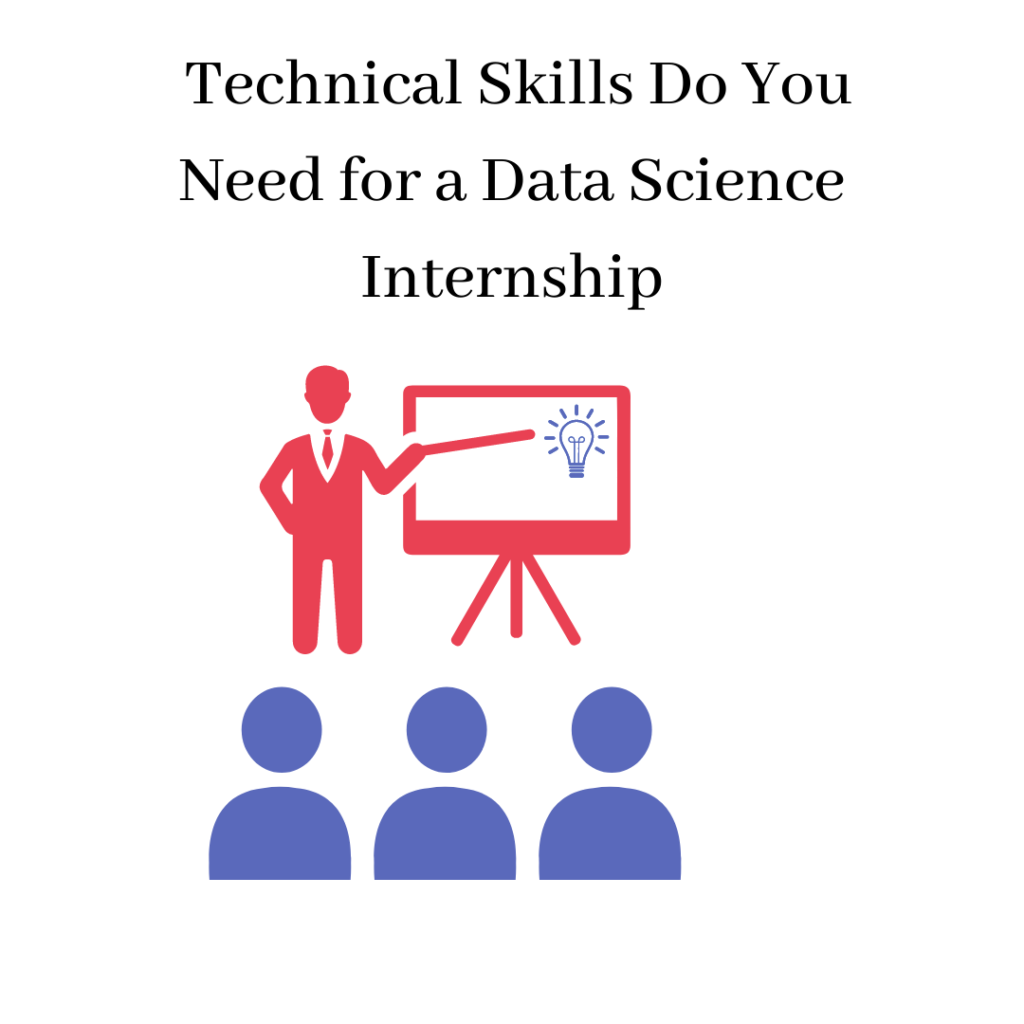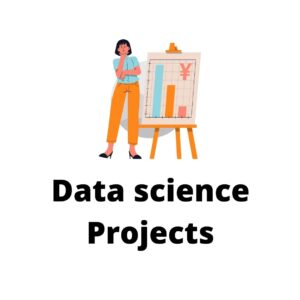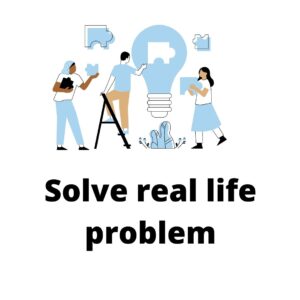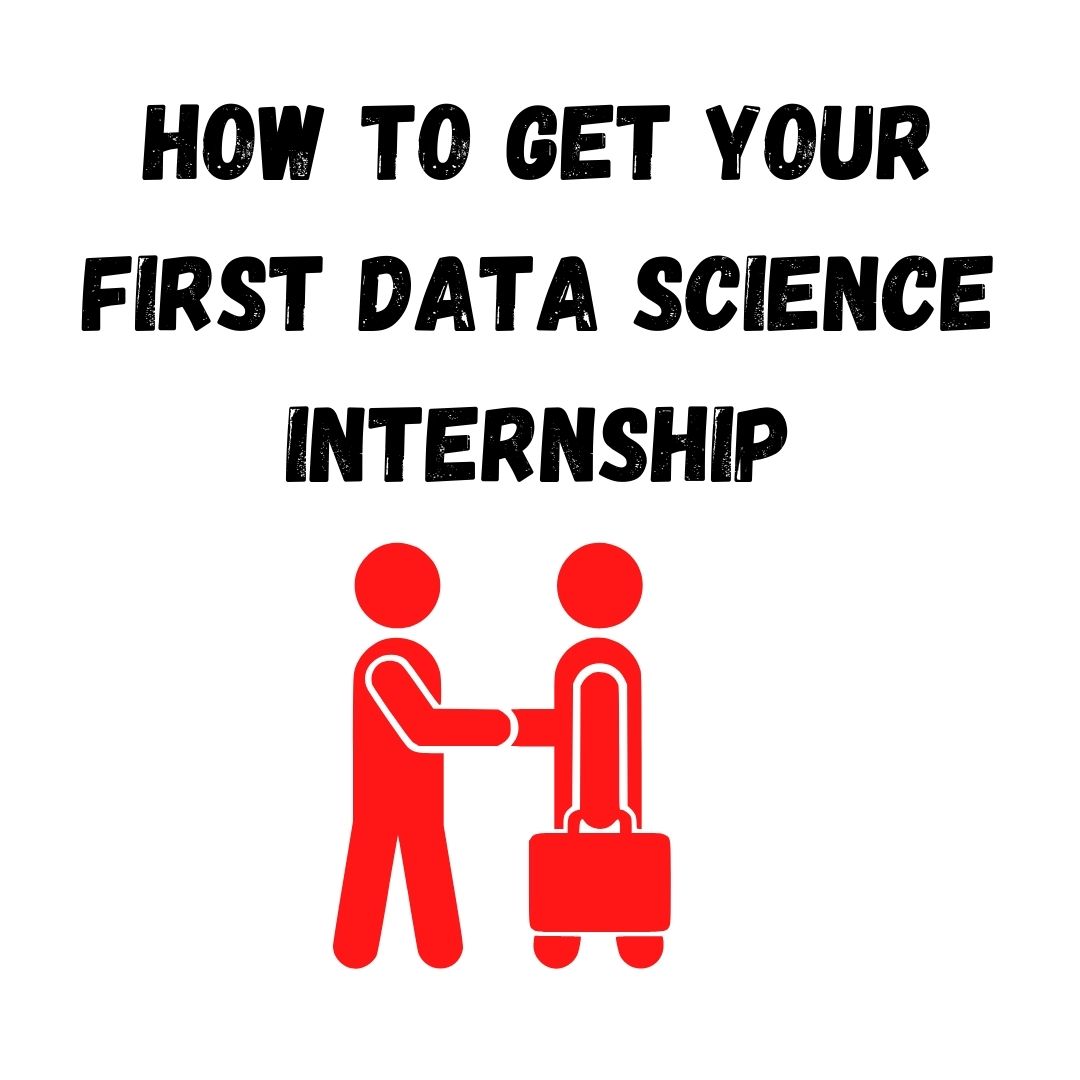How to Get Your First Data Science Internship
Data Science is a rapidly growing field with numerous opportunities. And it’s fantastic that you’ve decided to dive headfirst into this field! The first step is to secure an internship with your ideal company. While doing online projects and courses is a great way to learn Data Science, an internship is essential. It gives you real-world industry experience and the opportunity to collaborate with experienced Data Science professionals. This can only benefit your job search, and who knows, you might even get an offer from the same company! So this article will teach you how to get your first Data Science internship.
Table of Contents
ToggleWhat Technical Skills Do You Need for a Data Science Internship?

Let’s look at some of the skills required for a Data Science internship. Don’t be concerned if you aren’t an expert in these fields; this will come with time and experience. However, having some of these skills will only improve your chances of landing an internship!
1. Knowledge of Statistics and Probability
Statistical and Probability Skills are required for an internship in Data Science. That means you should understand the fundamentals of statistical analysis, such as statistical tests, distributions, linear regression, probability theory, maximum likelihood estimators, and so on. And that’s not all! While it is critical to understand which statistical techniques are appropriate for a given data problem, it is even more critical to understand which are not. Furthermore, there are many analytical tools that are extremely useful in Statistical Analysis, such as SAS, Hadoop, Spark, Hive, Pig, and so on, so you should be familiar with them.
Statistics: Navigating the Data Wilderness
- Like a compass in a forest, statistics guide us through the vast landscape of data.
- Patterns, outliers, and trends become visible, revealing stories within the numbers.
- Business decisions and scientific discoveries are driven by the insights statistics unveil.
Probability: The Enchantment of Uncertainty
- Probability transforms uncertainty into order, much like predicting outcomes at a carnival.
- It’s the foundation for predicting stock prices, weather forecasts, and more.
By quantifying uncertainty, we gain the power to make calculated decisions.
Detective Work with Data: The Duo’s Dynamic
- Statistics and probability serve as magnifying glasses for data detectives.
- They distinguish between coincidence and solid evidence, ensuring trustworthy insights.
Informed conclusions replace guesswork, making them essential in data science.
The Language of Informed Choices
- The synergy of statistics and probability empowers us across industries.
- From customer behavior prediction to optimizing operations, they’re versatile tools.
- They’re not just tools; they’re a language connecting data to actionable understanding.
Championing Data’s Realm: The Role of Statistics and Probability
- These two entities are the guardians of insights, leading us through data’s complexities.
- Navigating uncertainty, they bring clarity to decision-making in an unpredictable world.
- By harnessing their power, we transform data into knowledge, enriching data science.
Remember, statistics and probability aren’t mere concepts; they’re the instruments that turn data into insights and guide us through the intricate tapestry of information.
2. Programming Skills
Programming skills are also required for obtaining an internship in Data Science. Python and R are the most commonly used data science programming languages, so you should be familiar with at least one of them. Python is popular due to its statistical analysis capabilities and ease of use. Pyt.hon also has a number of packages for machine learning, data visualisation, data analysis, and other data science-related tasks (such as Scikitlearn). R also makes it very simple to solve almost any Data Science problem
Coding: The Palette of Data Science Creation
- Programming skills are the artist’s brushes in the canvas of data science.
- With languages like Python and R, you wield the power to manipulate and mold data.
Data Manipulation Mastery
- Just as a sculptor shapes clay, programmers reshape raw data into meaningful structures.
- Tools like Python’s pandas or R’s dplyr are your chisels for data transformation.
Efficiency and Automation Alchemy
- Programming lets you work smarter, not harder, by automating repetitive tasks.
- Code snippets become your spells, conjuring efficiency and saving valuable time.
Algorithmic Sorcery: The Heart of Machine Learning
- Machine learning models are your enchanted creatures, brought to life through code.
- Algorithms like decision trees, neural networks, and more spring to life through programming.
Visualization Enchantment
- Just as an artist uses colors to convey emotions, you use libraries like Matplotlib and ggplot2.
- Visualizations are your medium, turning complex data into insightful and engaging stories.
Debugging: Unraveling Digital Mysteries
- Programming isn’t without challenges; bugs are the riddles in your quest.
- Debugging is your adventure, where logic and analytical skills are your trusty companions.
Collaborative Conjuring
- In a team, your code becomes collaborative magic, seamlessly weaving efforts together.
- Version control systems like Git ensure your enchantments evolve harmoniously.
Turning Ideas Into Reality
- With programming, your data visions come to life. You build predictive models, uncover insights, and create tools that shape industries.
Innovation and Adaptation Alight
The programming landscape evolves, and as a data scientist, you’re the pioneer.
Learning new languages and tools is your way of embracing the ever-changing magic.
Universal Language of Possibility
No matter your domain, programming speaks universally to data.
From healthcare to finance, you converse with data through code, unlocking solutions.
In the grand tapestry of data science, programming skills are your thread, weaving together raw data, algorithms, and visualizations into a masterpiece of insights. As you code, you’re not just writing lines; you’re crafting the story of data’s journey from chaos to clarity.
3. Machine Learning
You should also be familiar with fundamental Supervised and Unsupervised Machine Learning algorithms such as Linear Regression, Logistic Regression, K-means Clustering, Decision Tree, K Nearest Neighbor, and so on. Because the majority of Machine Learning algorithms can be implemented using R or Python libraries, you do not need to be an expert in them. However, knowing how the algorithms work and which algorithm is required based on the type of data you have is still beneficial.
Machine Learning: The Art of Data’s Evolution
- Machine learning is the wizardry that empowers computers to learn from data and improve over time.
- Just as a musician hones their skills, models refine themselves with more data.
Algorithms: Spells of Insight and Prediction
- Algorithms are your magical spells, transforming raw data into predictions and classifications.
- Decision trees, support vector machines, and neural networks are your incantations.
Supervised Learning: Guided by Examples
- Like an apprentice learning from a mentor, models are trained on labeled data.
- They learn patterns and relationships, ready to predict new outcomes.
Unsupervised Learning: Discovering Hidden Realms
- Unsupervised learning is your expedition into uncharted territories of data.
- Clustering and dimensionality reduction are your compass and map.
Deep Learning: Unveiling Complex Patterns
- Deep learning, like peering into a crystal ball, reveals intricate patterns in massive datasets.
- Neural networks mimic the human brain’s architecture, deciphering intricate signals.
Feature Engineering: Crafting the Magic Ingredients
- Like an alchemist, you transform raw features into powerful predictors.
- Feature selection and extraction craft the elixir that fuels accurate models.
Model Evaluation: Separating Truth from Illusion
- Evaluating models is akin to a magician perfecting their illusions.
- Metrics like accuracy, precision, and recall reveal the model’s true effectiveness.
Overfitting and Regularization: Balancing Act of Control
- Like a tightrope walker maintaining balance, you prevent overfitting with regularization.
- Techniques like L1 and L2 regularization ensure models don’t get lost in noise.
Real-World Sorcery: Applications Across Industries
- Machine learning isn’t confined to one realm; it’s a multidimensional spellbook.
- From healthcare diagnosing diseases to finance predicting market trends, the possibilities are vast.
Continuous Learning: The Sorcerer’s Journey
- Just as a magician never stops learning new tricks, machine learning experts keep exploring.
- Staying updated with new algorithms and techniques keeps your spells powerful.
Ethics and Responsibility: Guiding the Magic’s Intent
- Like wielding powerful magic, you must be responsible with your creations.
- Ensuring fairness, transparency, and bias mitigation is part of being an ethical practitioner.
In the realm of data science, machine learning is the wand that turns data into foresight. Your algorithms are spells, your models are enchanted beings, and your knowledge is the key that unlocks the future’s secrets. Through careful crafting and diligent exploration, you wield machine learning to shape the world of tomorrow.
4. Data Wrangling and Management
You must be knowledgeable in data management, which includes data extraction, transformation, and loading. This means gathering data from various sources, transforming it into the appropriate format for analysis, and finally loading it into a data warehouse. There are various frameworks available to handle this data, such as Hadoop, Spark, and others. Data Wrangling is an important part of Data Science because it involves cleaning and unifying data in a coherent manner before it can be analysed for actionable insights.
Data Wrangling: Sculpting Raw Data into Wisdom
- Data wrangling is the art of taming unruly data, just as a sculptor shapes raw material into a masterpiece.
- You mold and transform data, preparing it for the grand unveiling of insights.
Data Collection: Gathering Ingredients for the Masterpiece
- Like a curator assembling a collection, you gather data from various sources.
- Structured databases, spreadsheets, and APIs are your galleries of raw material.
Data Cleaning: Polishing the Raw Gem
- Cleaning data is your jeweler’s work, ensuring clarity and brilliance.
- Removing duplicates, correcting errors, and handling missing values are your polishing techniques.
Data Transformation: Weaving a Coherent Narrative
- Transforming data is like crafting a compelling story from scattered pages.
- You reshape variables, merge datasets, and engineer new features, creating a coherent narrative.
Data Integration: Harmonizing Disparate Voices
- Integrating data is your conductor’s role, orchestrating a symphony from diverse sources.
- You harmonize data from different systems, languages, and formats into a unified composition.
Data Exploration: Unveiling Hidden Treasures
- Exploration is your archaeologist’s adventure, uncovering insights buried beneath layers.
- Descriptive statistics and visualizations reveal patterns and stories within the data.
Data Quality Assurance: Ensuring the Masterpiece’s Integrity
- Quality assurance is your guardian’s watch, ensuring the masterpiece is free from flaws.
- You validate data against standards, ensuring accuracy and consistency.
Data Storage and Retrieval: Building the Gallery
- Storing data is like curating an art gallery, where each piece is stored for easy retrieval.
- Databases, data warehouses, and data lakes are your exhibition halls.
Data Security and Ethics: Protecting the Legacy
- Just as a museum safeguards valuable art, you protect data from unauthorized access.
- Adhering to privacy regulations and ensuring ethical use is your responsibility.
Continuous Maintenance: Nurturing the Living Artwork
- Like a conservator, you maintain and update your data masterpiece.
- Data evolves, and your vigilance ensures its continued relevance and accuracy.
Mastering the Art: Honing Your Craft
- Data wrangling is a skill honed over time, like a painter refining their technique.
- As you master the art, you gain the ability to transform chaos into clarity, uncovering insights.
5. Communication Skills
Yes, this is not a technical skill, but it can help you stand out as a candidate for a Data Science internship! This is due to the fact that, while you understand the data better than anyone else, you must translate your findings into quantifiable insights for a non-technical team to aid in decision making. Data storytelling is another aspect of this. If you can present your data in a storytelling format with concrete results and an engaging story, your value will automatically increase.
Communication: The Bridge Between Data and Understanding
- Communication skills are the bridge that connects the intricate world of data to the minds of decision-makers.
- Just as an interpreter translates languages, you translate complex insights into actionable understanding.
Storytelling with Data: Crafting Compelling Narratives
- Data is your protagonist, and you’re the storyteller weaving its journey into a compelling narrative.
- Visualizations, charts, and graphs are your tools to captivate and convey meaning.
Clarity Amid Complexity: Making the Complex Accessible
- You’re the translator of data’s language, converting complexity into clarity.
- Whether speaking to technical experts or non-technical stakeholders, your message remains clear.
Customized Communication: Adapting to the Audience
- Just as a tailor designs clothes to fit perfectly, you tailor your communication to suit your audience.
- Technical jargon for data experts, simplified terms for executives – you choose your words strategically.
Data Presentations: Turning Numbers into Insights
- Presentations are your gallery show, where data comes alive on the canvas of screens.
- You combine visuals, explanations, and insights to captivate and engage your audience.
Influencing Decisions: Transforming Insights into Action
- Your insights are the compass guiding decisions, the lantern illuminating the path.
- Through effective communication, you empower stakeholders to take informed actions.
Transparency and Trust: Forging Credibility
- Like a jeweler showcasing a gem’s clarity, you exhibit transparency in your methods and findings.
- Clear explanations of how you arrived at conclusions build trust in your work.
Feedback Loop: Refining Insights Through Interaction
- Communication isn’t one-sided; it’s a dialogue that refines insights.
- Feedback from colleagues and stakeholders helps you polish your analyses.
Collaborative Art: Enhancing Team Synergy
- Communication is your collaborative art form, harmonizing diverse perspectives.
- Through discussions and presentations, you create a symphony of understanding within your team.
Ethical Responsibility: Communicating Impact and Implications
- Just as an ethical journalist reports the truth, you communicate the potential impacts and ethical considerations of your findings.
- Your insights are a compass that guides responsible decisions.
Continuous Growth: Sharpening Your Communication Toolkit
- Like a craftsman refining their tools, you continuously improve your communication skills.
- Writing, public speaking, visualization – each facet contributes to your mastery.
Create a Digital Presence (Online Data Science Portfolio)
Projects must be accomplished.

- I believe that putting your knowledge into practice is the best way to learn anything. Nothing says “I know this technique” like putting it on display in a project. Building an end-to-end project gives you an idea of the various possibilities and challenges that a data scientist may face on a daily basis.
- Look for open source projects that are relevant to your field of interest. There is no shortage of data on the internet, believe me. I’m a huge fan of fiction, so I enjoy analysing the work of my favourite authors using NLP. This demonstrates your enthusiasm for data science and gives you an advantage in the eyes of your potential employer.
Here are a few practise problems to help you gain valuable experience.
s.no | Project Name | level |
1 | Analyzing sentiments | Beginner |
2 | Detecting credit card frauds | Beginner |
3 | Detection of breast cancer | Beginner |
4 | Detection of fake news | Beginners |
5 | Forecasting web traffic | Beginner |
6 | Uber data analysis | Beginner |
7 | Climate change’s impact on food | Beginner |
8 | Predicting forest fire | Beginners |
9 | Gender and age detection | Advance |
10 | Detecting Parkinson’s disease | Intermediate |
Create a GitHub Profile
At this point, you should also start building your GitHub profile. This is essentially your data science resume, which is accessible to anyone in the world.
To assess a candidate’s potential, most data science recruiters and interviewers look at his or her GitHub profile. While working on your projects, you can list the problem statement and code on GitHub at the same time. I’ve created a small checklist that you can use the next time you upload code to GitHub:
- Include the problem statement.
- Create a simple readme file.
- Create clean code
- Include comments in the code.
- Include as many personal/course projects as you can.
- If you’re at that level, contribute to open source projects.
Write Blogs
- I’ll reveal a big secret that helped launch my data science career: writing articles. When I’m learning a new concept, I make it a point to take notes. It’s simple to turn that into an article later. This helps me understand the technique much more clearly and lucidly.
- You should follow suit! Our community is delighted to share their ideas and feedback with you. When you make your articles public, people frequently share their thoughts – for example, “adding a visualisation of actual vs predicted could be helpful,” which can help you improve.
- Quora can be thought of as an alternative to blogging (which is where I first started writing). It aided in breaking down a complex topic into simple words.
Create and optimize your LinkedIn Profile

- LinkedIn is the largest professional network on the planet. Even if you’re a recent graduate or still in school, you should be on it.
- Recruiters frequently use LinkedIn to either verify your profile or contact you if an opportunity arises. Consider it your backup resume or a digital version of your paper resume. If you apply for an internship and your profile is not up to date (or does not exist), you may be disqualified.
- Optimize your LinkedIn profile for the internship you’re interested in. Update your previous experience (if any), educational level, projects, and areas of interest. Make a profile now if you haven’t already. You should also start building your network by connecting with data science professionals.
Dos and Don'ts When Writing a Data Science Resume
Your resume is essentially a highlight reel of your professional career. Because it is the first thing a recruiter/hiring manager looks at, creating the perfect resume is critical in your quest for an internship.
Even if you have every skill listed in an internship’s requirements section, there’s a good chance you won’t be called in for an interview if your resume isn’t up to par.
You must, absolutely must, devote significant time to creating and perfecting your resume.
Get ready for your Data Science Internship Interview.
The interview process is undoubtedly the most difficult aspect of obtaining a data science internship. What aspects of your resume will the recruiter look at given that you have no prior work experience in this field? What skills should you highlight in your resume and during the interview?
Great questions! Knowing how to navigate these treacherous waters could mean the difference between getting the internship or not.
Structured Thinking

In the complex world of data science, the ability to structure your thoughts is a valuable skill. Your ability to break down a problem statement into smaller steps will be evaluated by the interviewer. The gold mine is in how you do it.
It is necessary to identify the end goal for any given problem statement. The next step is to comprehend the information provided and outline the steps necessary to achieve the desired outcome. And all of this takes place in a limited amount of time (the interviewer does not have all day!). Do you see why having a structured thinking mindset is so important?
To assess your structured thinking abilities, you will be asked a question such as, “How many emails are being sent right now?” That was the question I was asked during my interview. How many red cars are there on the road in Bangalore? How many cigarettes are sold in India per day?
Understanding of the Company to Which You Are Applying
You may believe that this point is irrelevant to the discussion. This isn’t necessary to mention because everyone reads the job description before applying. It’s an excellent point.
However, simply perusing the JD is insufficient.
Recruiters frequently tell us that prospective candidates arrive without having read about the role they are interviewing for. I’ve seen people start an internship and then quit after a few weeks because they didn’t like their job.
What will you discover during your internship?
What does an internship provide that textbooks, MOOCs, and videos do not?
Practical knowledge.
When reviewing your profile, the hiring manager will value one thing above all others. During my internship with Vista Academy, I realised how useful this is.
You can learn a lot from your internship if you go in with an open mind and a willingness to learn every day. That is how you achieve success in data science!
How to Handle Real-World Problems

You would be working on a real-life project during your internship. This is invaluable experience. Once you’re on board, you might well find yourself entrenched in the end-to-end data science lifecycle, including defining the problem statement and building models.
If you previously participated in data science competitions, you will have an idea about the different challenges data scientists come across. But here’s the caveat.
The problem statements and the datasets provided in these competitions are very different from real-world scenarios. The datasets are messy and unstructured in the industry. There’s a ton of data cleaning work required before any model can be built.
In fact, don’t be surprised if 70-80% of your tasks involve data cleaning.
You will learn how to structure a problem statement, understand the domain and the data required to solve the problem, and then figure out sources to extract that data. The next step is to get knee deep into research. Find out the approaches other data scientists have taken to solve similar problems.
This will give you a fair idea about what should work well and what is not worth investing time on. While experiments are encouraged in data science, there’s a limit to how much creative freedom you’ll get from your manager. Filter out the aspects you know won’t work beforehand.
Problem Understanding:
- Clearly define the problem you’re trying to solve. Understand the context, objectives, and desired outcomes.
- Break down the problem into smaller components. Identify the main variables, constraints, and potential variables of interest.
Data Collection and Exploration:
- Gather relevant data from various sources. Ensure the data is clean, accurate, and comprehensive.
- Explore the data to understand its structure, patterns, and potential challenges. Visualize the data using graphs and summary statistics.
Problem Framing and Hypothesis Generation:
- Formulate hypotheses based on your understanding of the problem and data exploration.
Define clear research questions that your analysis aims to answer.
Data Preprocessing and Cleaning:
- Clean and preprocess the data to handle missing values, outliers, and inconsistencies.
- Transform variables if necessary (e.g., normalization, feature engineering) to ensure they are suitable for analysis.
Feature Selection and Engineering:
- Select the most relevant features that contribute to solving the problem.
- Engineer new features that might provide additional insights or improve model performance.
Model Selection and Building:
- Choose appropriate machine learning algorithms based on the nature of the problem (classification, regression, clustering, etc.).
- Train and validate different models to identify the best-performing one.
Model Evaluation and Validation:
- Evaluate the chosen model(s) using appropriate evaluation metrics (accuracy, precision, recall, F1-score, etc.).
- Implement cross-validation techniques to ensure your model’s generalization to new data.
Interpreting Results:
- Interpret the model’s outputs to gain insights into the problem.
- Analyze feature importance, coefficients, or other relevant metrics to understand the model’s decision-making process.
Fine-Tuning and Optimization:
- Fine-tune your model’s hyperparameters to achieve the best possible performance.
- Use techniques like grid search or random search to systematically explore parameter combinations.
Communication of Results:
- Present your findings and insights in a clear and understandable manner.
- Use visualizations, summaries, and clear explanations to convey the implications of your analysis.
IIteration and Improvement:
Iterate through the process based on feedback and new insights.- Collaborate with colleagues, mentors, or domain experts to refine your approach.
Ethical Considerations and Bias:
- Address any ethical considerations related to your analysis, especially when dealing with sensitive data or potential biases.
Ensure fairness, transparency, and responsible use of your results. - Deploying Solutions:
If applicable, deploy your model or solution to a real-world environment.
Monitor its performance and adapt to changing conditions or new data.
Continuous Learning:
- Reflect on the challenges you encountered and the strategies you used to overcome them.
- Continuously learn from your experiences to become a more effective problem solver.
Remember that real-world problems can be complex and may not always have straightforward solutions. Adaptability, creativity, collaboration, and a commitment to learning are essential traits for successfully handling these challenges in the field of data science.

